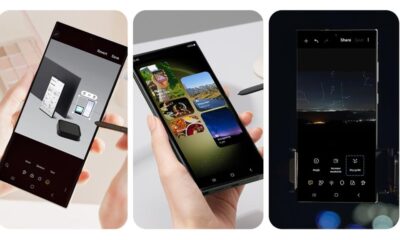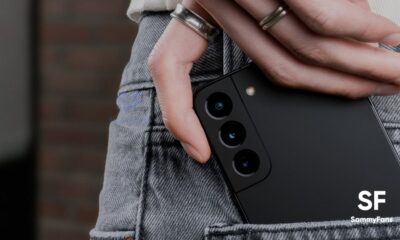Tips
15 smart Samsung One UI 4.1 Gallery app tips
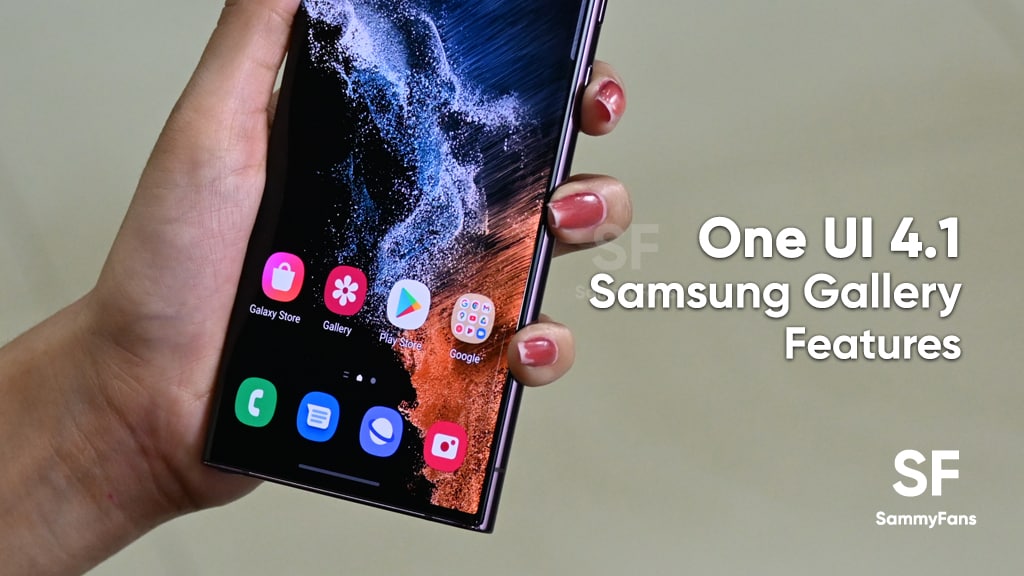
Samsung smartphones come with the company’s in-house Gallery app. Samsung Gallery app stands out with tons of editing tools, organization options, and a neat OneDrive integration. Meanwhile, it has been further improved with the all-new Object eraser and other editing tools in One UI 4.1.
Among various new features, One UI 4.1 Photo Remastering is the most notable change. It lets you improve the quality of dark, out-of-focus, or low-resolution images. It reduces blur, eradicates noise, and also increases the resolution of your images, and more.
Join SammyFans on Telegram
There’s a lot to do with your Galaxy phone’s Gallery app. Here I’m going to give you some smart Samsung One UI 4.1 Gallery tips that will change the way you use your phone’s Gallery.
DOWNLOAD SAMMY FANS APP

Smart Samsung One UI 4.1 Gallery tips
Enable Samsung Gallery Labs:
Gallery Labs is a hidden menu and can be enabled in a similar style ad Developer options. It has some experimental features in Samsung Gallery.
- Open Samsung Gallery.
- Tap the 3-dot menu button in the bottom-right corner.
- Tap Settings.
- Scroll down and head over to About Gallery.
- Repeatedly tap the Gallery version (the numbers, not the word “Gallery”) 7-8 times.
- You should see a toast notification saying that Gallery Labs has been enabled.
- Go back to Gallery settings.
- Scroll to the bottom of the list where you should see the Gallery Labs option.

Move photos to Secure Folder:
Samsung Secure Folder keeps your private photos, videos, files, apps, and data safe and secure. The service also allows you to add a passcode or biometric lock to keep your data safe from any others eyes.
- Select the photos, videos, or albums that you want to move to Secure Folder.
- Tap the More button in the bottom navigation drawer.
- Select the Move to Secure folder option.
If you are using it for the first time, you will have to set up a Secure Folder by granting it the necessary permissions and entering a password/pattern/PIN lock.

Give Object Eraser a shot:
With One UI 4.1 Object Eraser, users can now easily remove not only background disturbances but also shadows in the subject or reflections in the picture.
- Open the photo in the Samsung Gallery app from which you want to remove an object.
- Tap the Pencil icon from the bottom toolbar to enter into editing mode.
- Tap the 3-dot menu button in the bottom right corner.
- Select Object eraser.
- Tap or draw on the object that you want to remove from the photo.
- You can erase shadows and reflections by selecting the appropriate option.
- Tap Erase to see the results.

Add spot color to your photos:
Spot color allows you to turn a photo black and white, with only some specific parts or objects remaining in color. This can be used to make certain subjects pop in a photo.
- Open the photo in the Samsung Gallery app from which you want to re-color an object.
- Tap the Pencil icon from the bottom toolbar to enter into editing mode.
- Tap the 3-dot menu button in the bottom right corner.
- Select Spot color.
- The photo is automatically converted into black and white.
- Tap on an object that you want to be in color.
- The changes will also be applicable for all objects or subjects of the same color in the photo.
- You can use the Remove color or Erase color options to remove them from unwanted objects.
- Tap Done to apply the changes.
- Select Save from the top right corner to save the photo.

View and edit Exif data:
Samsung Gallery makes it easy to view the Exif (Exchangeable image file format) data of the photos and videos you shoot. You can even edit this data if you wish. To view the Exif data like resolution, size, and geotagged location, simply open a photo or video and swipe up.
- Tap the arrow near the EXIF data in the Samsung Gallery app.
- You’ll see a more detailed look at the EXIF data.
- Tap Edit in the top right corner.
- Change the date, time, file name, and the geotagged location of the file.
- Select Save when done.
Hide private albums:
New folders containing photos and videos on your phone appear as a new album in the Gallery app, including folders created by third-party apps. If you want to keep your gallery clean and organized, you can hide unwanted albums and folders.
- Open Samsung Gallery app.
- Tap the 3-dot menu button in the top right corner.
- Tap hide or unhide albums.
- Toggle the albums/folders you want to hide.
- You cannot hide some folders like Camera and Screenshots.

Drag and drop photos content between albums:
If you have more than one folder or album in Samsung Gallery, you can move media files between them with a simple drag and drop gesture.
- Open Samsung Gallery app.
- Select multiple photos and videos and long press on them.
- This will bring up the list of available folders or albums in a sidebar on the left.
- Drag and drop the items to the desired folder.

Sync Samsung Gallery with Microsoft OneDrive:
Samsung offers native OneDrive integration in its Gallery app. If you’re already subscribed to Microsoft 365, you can take advantage of 1TB of OneDrive space and back up all your photos and videos.
- Open Samsung Gallery app.
- Tap the 3-dot hamburger menu button in the bottom right corner.
- Tap Settings.
- Select Sync with OneDrive.
- Agree to the terms and conditions and then tap Connect.
- Proceed to connect your Samsung and Microsoft accounts.
- You’ll need to sign in to your Samsung account if you have not already done so.
- Then log in with your Microsoft account.
- Now, all photos and videos in your Gallery are automatically backed up to OneDrive.

Recover deleted photos and videos:
Accidentally deleted an important picture while freeing up storage space on your phone by deleting useless photos and videos? Don’t worry, Samsung Gallery has the ability to recover deleted photos and videos for up to 30 days.
- Open Gallery of your phone.
- Tap Menu (three dots).
- Select Trash.
- Tap Edit.
- Select photos or videos you want to restore.
- Finally, tap Restore.

Add portrait effect to photos:
You can add a portrait effect to photos after taking a shot. This feature works best with selfies and your mileage may vary with shots taken with the primary rear camera.
- Open the photo in the Samsung Gallery app.
- Tap the 3-dot menu button in the bottom right corner.
- Select the Add portrait effect option.
- Samsung Gallery will then analyze the photo and automatically add the blur effect.
- A slider will be shown which you can use to adjust the blur intensity.
- Tap Apply when done to save the changes.
- Alternatively, you can keep the original photo unmodified by using the Save as copy option from the 3-dot menu in the top right.
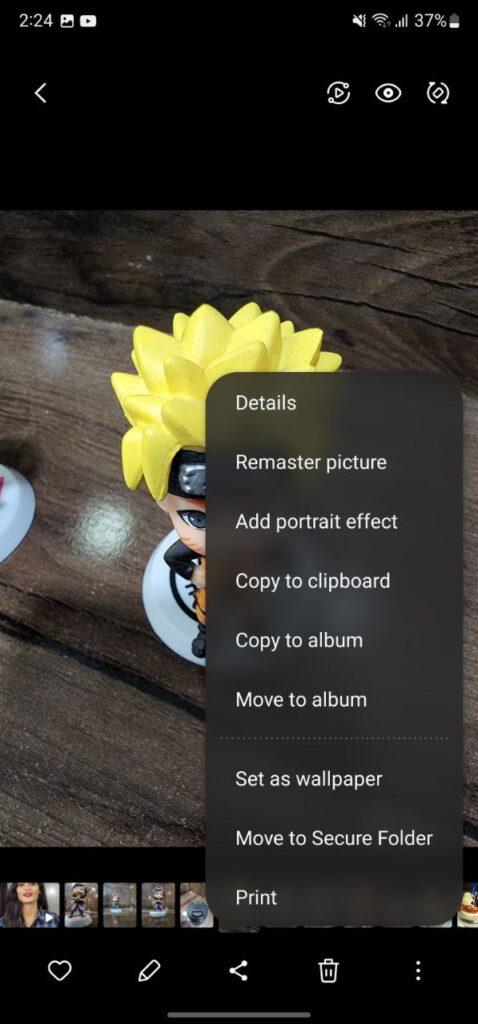
Remaster your photos:
Samsung Gallery app has remaster option to tweak your photos.
- Open the photo in the Samsung Gallery app.
- Tap the 3-dot menu button in the bottom right corner.
- Select the Remaster picture option.
- The photo will be analyzed and a before/after will be shown so that you can easily make out the differences.
- If you like the changes, tap Save.
- You can save the edited photo as a separate copy by tapping More and selecting the Save as copy option.

Use a photo in Samsung Gallery as your custom wallpaper:
You can set any photo that you like as your phone’s home screen, lock screen, or Always-On Display wallpaper directly using Samsung Gallery.
- Open the Samsung Gallery app followed by the photo you want to set as wallpaper.
- Tap the 3-dot menu button in the bottom right corner.
- Select Set as wallpaper.
- Now select where you want to set the wallpaper: Home screen, Lock screen, Always On Display, Call background or Watch face.
- Depending on your option, a preview will be shown where you can adjust the crop.
- Confirm your action when done.

Bixby Vision:
Samsung is a useful Google Lens-like feature that’s baked into Samsung Gallery. You can use Bixby Vision to identify objects in your photos or even copy text from images.
- Open the Samsung Gallery app followed by a photo of your choice.
- Tap the Bixby Vision icon located in the middle of the toolbar on the top.
- Bixby will then scan the photo to find text or subjects.
- If text is detected in the photo, you can copy, translate or search for it on the web.
- You can view similar images on Pinterest by tapping the Find icon at the bottom.

Let Samsung Gallery analyze your photos and make suggestions:
Samsung Gallery can analyze your photos and recommend changes like adding portrait effects, remastering them to enhance their look, and deleting duplicate photos to free up space.
- Open the Samsung Gallery app.
- Tap the hamburger menu button located in the bottom right corner.
- Select Suggestions.
- Recommendations for various photos on your phone will be shown here.
- You can tap on a suggestion to read more about the recommended changes.
- A before/after comparison will also be shown for comparison purposes.
- Proceed to Save the photo if you like the changes.
- You can also directly share the edited photo or remove the changes.

View a photo landscape mode without rotating your Samsung Galaxy phone:
You don’t need to enable auto-rotate to view a photo in landscape mode in the Samsung Gallery app. Simply tap the Rotate button in the Gallery’s image viewer to switch to landscape view or vice versa. It is a useful feature to have since it does not affect the system’s auto-rotate setting.
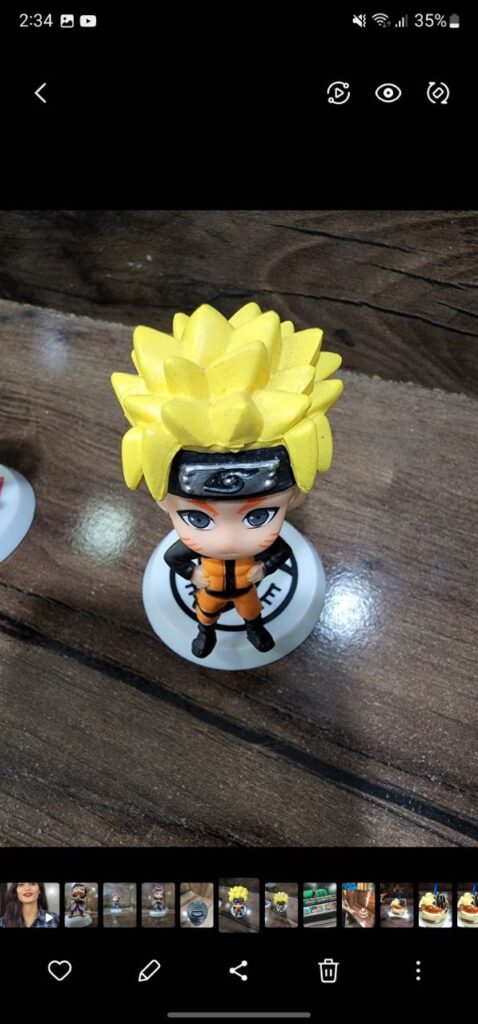
Get notified –
Aside from SammyFans’ official Twitter and Facebook page, you can also join our Telegram channel, follow us on Instagram and subscribe to our YouTube channel to get notified of every latest development in Samsung and the One UI ecosystem. Also, you can follow us on Google News for regular updates.
Tips
Galaxy AI: How to use PDF Overlay Translation feature on your Samsung device

Studying e-books and journals in foreign languages can be difficult, especially when you come across unfamiliar words or phrases. For that, Samsung offers Galaxy AI-powered PDF Overlay Translation feature. With this feature, you can instantly translate PDF documents without needing any extra apps which helps you understand study material more quickly and effectively.
Samsung PDF Overlay Translation feature automatically translates the text on your screen. After that, you can read documents in a foreign language without having to switch between apps or spend time searching for words.
Whether you’re reading any paper or an e-book, the PDF Overlay Translation tool can help you stay focused by making translations appear directly on the document. Below you can check how you can use it on your Samsung phone.
How to Use Samsung PDF Overlay Translation Feature
For that, you just need to follow a few steps given below
- Open the Samsung Notes app on your Galaxy device
- Create a new document by clicking the appropriate icon.
- Tap the “+” icon, select PDF, and find the PDF you want to translate.
- Once your PDF is open, tap the Galaxy AI icon at the top of the screen.

You can choose to either Summarize or Translate PDF depending on what you need. You can also pick the language you want to translate the document into.
This feature is very useful, mainly for those who need to read documents in another language, whether for school, work, or personal growth. It saves time and helps you understand content better to study more efficiently and without stress.
If you have an eligible Samsung Galaxy device, you can try this feature now to read documents in another language.
Tips
Getting ready for the One UI 7.0 Beta: Here’s your complete guide
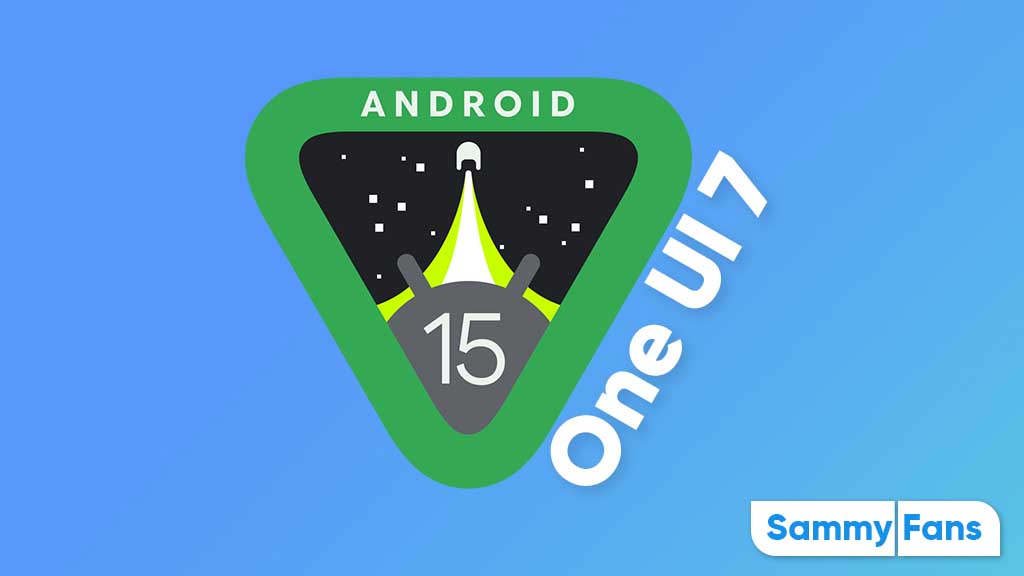
Samsung fans are eagerly waiting as the company is set to unveil the One UI 7.0 beta program. The One UI interface has enhanced over time, making things easier, smoother, and packed with more features for users. Here’s everything you need to know to get ready for this major One UI update.
The One UI 7.0 is aimed to introduce significant enhancements to Samsung’s UI, built on top of Android 15. This beta phase allows users to experience these changes before the official release.
Remember, Samsung has not yet announced a specific date but has confirmed that the beta might start by the end of 2024. Given current trends and reliable leaks, we might expect it to be around November. Considering the stable One UI 7 launch with the Galaxy S25, the beta program might be shorter than previous ones if it doesn’t start soon.
Why you should join the One UI Beta program?
Beta testing isn’t just for tech lovers; it’s an opportunity to experience new features first. You will experience the potential design revamps, new privacy features, and enhanced personalization options.
In addition, your feedback can directly contribute to fixing bugs and enhancing features before the public/stable release. You will be among the first to use Samsung’s latest software features.

Eligibility and Registration for the Beta Program:
The current flagship models like the Galaxy S24 series, Galaxy Z Fold 6, and Galaxy Z Flip 6 are eligible for the One UI 7.0 beta program. Recent Galaxy Tab S9, S23 series, and Fold5 are also likely candidates for the beta testing.
How to Register:
1. Get Samsung Members App:
- This app is your gateway to the One UI 7.0 beta program.
- Download or Update: Ensure you have the latest version of the Samsung Members app from the Galaxy Store.
- Registration: Within the app, look for a banner or notification about the One UI Beta Program. Click on it to register.
2. After registration:
- Go to Settings > Software Update > Download and Install. If the beta is available, you’ll see an option to update.
Preparation Steps Before Joining the Beta:
- Backup Your Data: Beta software can be unstable. Back up your photos, contacts, and important files to avoid any loss.
- Understand the Risks: Beta software might have bugs. Your device could experience performance issues or battery drain.
- Check for Space: Ensure your device has enough storage for the beta update, typically 15-20 GBs.
- Stable Internet Connection: You’ll need a good internet connection to download the update.
Feedback and Support:
- If you encounter issues, use the Samsung Members app to report them promptly. This will help Samsung to fix or improve the One UI 7.0.
- Samsung often releases multiple beta versions. Keep your device updated to get the latest fixes and features.
- Engage with forums or social media where other beta testers share their experiences and solutions to common problems. You can also connect with me on X, here.
Joining the One UI 7.0 beta gives you an early look at new features and helps Samsung make the software better. It’s easy to get ready for it: follow the steps, stay cautious about the possible risks of beta software, and dive into the future of Samsung’s user interface.
Tips
Here’s how to create GIFs with Samsung’s Edge Panel
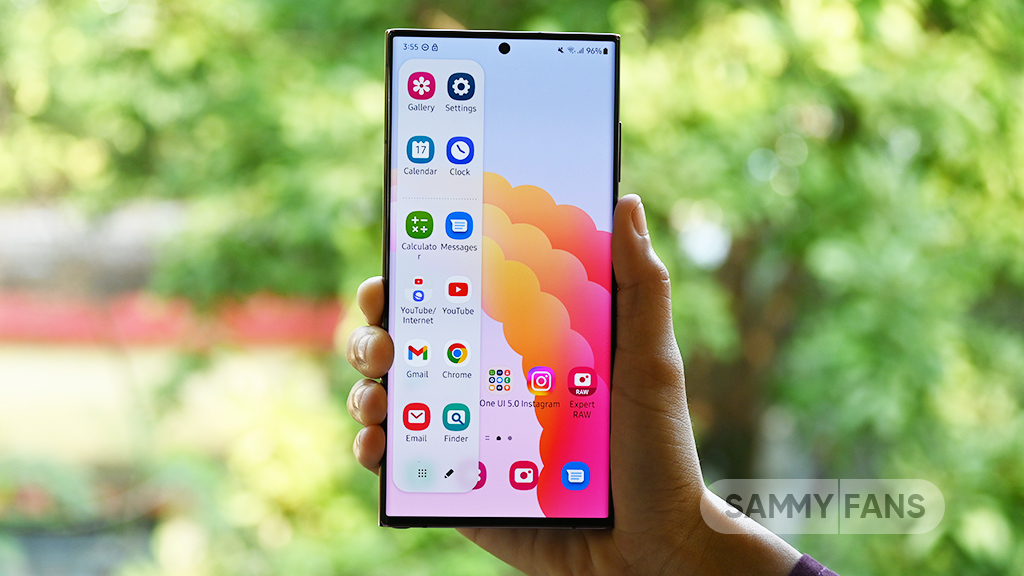
If you want to create GIFs easily on your Samsung device, the Smart Select feature in the Edge panel is best for it. The company recently updated the Samsung Capture app for One UI 6.1.1, which allows easier GIF creation to improve your sharing options.
Ahead of start making GIFs, make sure your Samsung Capture app is updated to the latest version. The latest version 5.8.56.4 is available on most Samsung models and v5.8.61.4 for the Tab S10.
You can install the latest version on your Samsung phone via Galaxy Store >> Menu option >> Updates. Now, look for the Samsung Capture app in the update list and select it to install the latest version.

Once your app is updated, using the GIF creation feature becomes easy. You just have to follow to create GIFs in the Samsung Edge Panel.
- Swipe from the edge of your screen to access the Edge panel.
- Tap on the Smart Select option to get started.
- Select the part of the screen you want to capture as a GIF.

- Tap the More icon and then press “Create GIF”. You will be prompted to press the record button to start capturing your GIF.

For Galaxy Fold and tablet users, the GIF creation function becomes immediately available after completing the area selection. This feature provides an amazing way to express your creativity or share moments with friends and family. Try out this feature now!
7 Essential charging tips to enhance Samsung Galaxy Buds battery life



